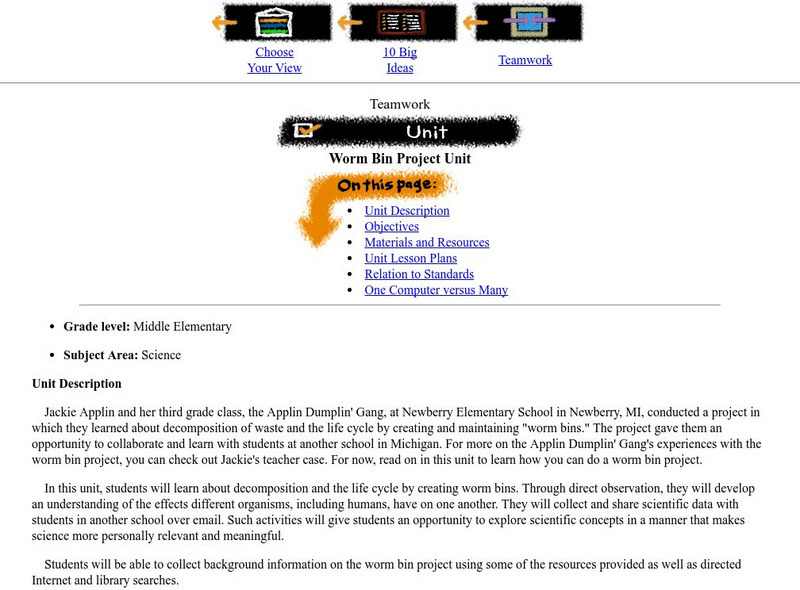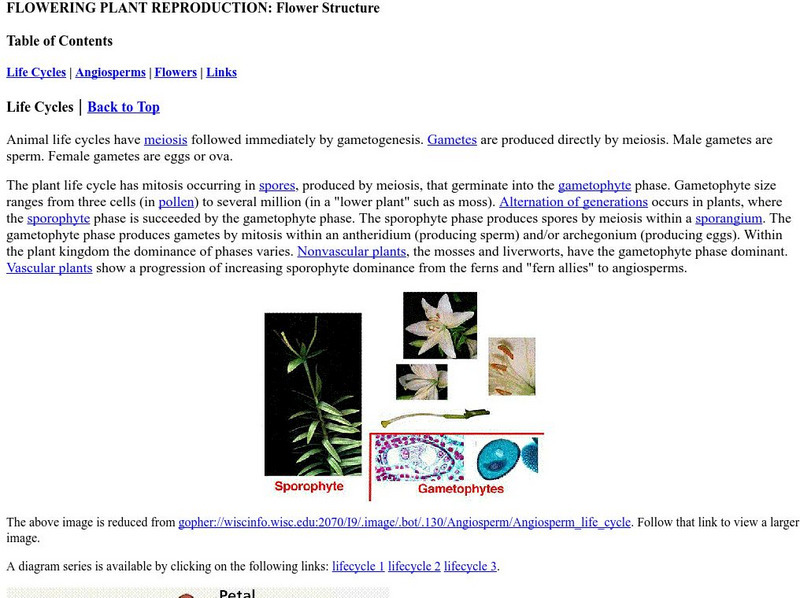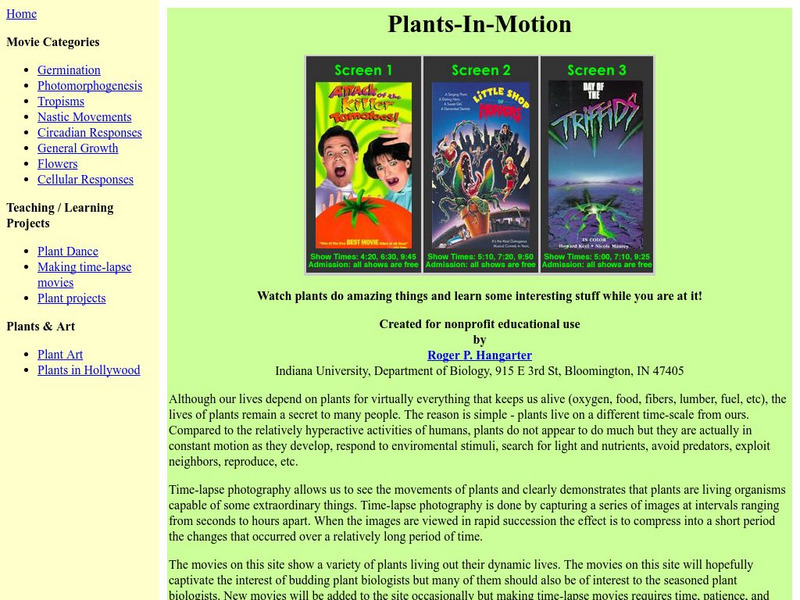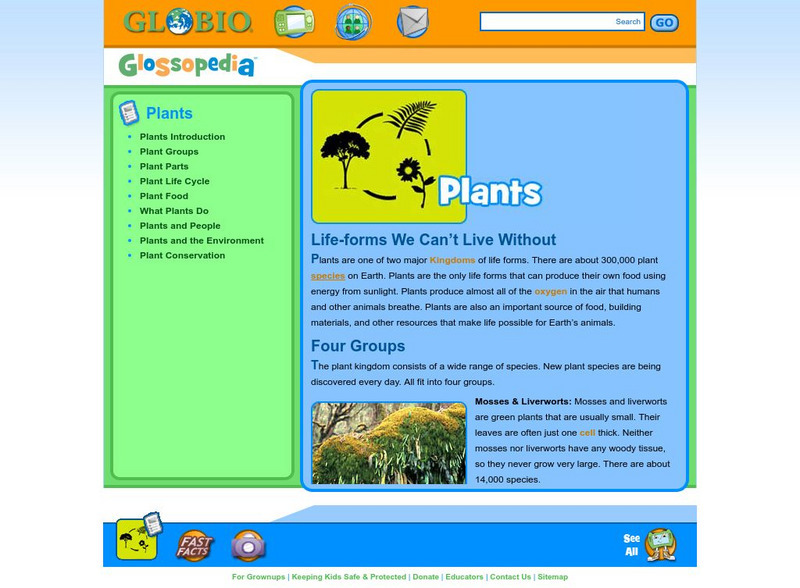ClassFlow
Class Flow: Life Cycles
[Free Registration/Login Required] Through this unit, children learn that plants and animals reproduce as part of their life cycle and that in every life cycle there are distinct processes and stages. They should begin to understand how...
Science Education Resource Center at Carleton College
Serc: Investigating Decomposition Processes of a Plant
Young scholars observe the decomposition of a pumpkin under controlled circumstances in a classroom. This can be used to lead discussions on recycling, trash, composting, or life cycles.
BiologyWise
Biology Wise: Life Cycle of a Flowering Plant
Explains what the parts of a flowering plant are and how the plant develops from a seed. Discusses fertilization through pollination, the formation of the endosperm and fruit, and the repetition of the life cycle all over again when the...
Science & Plants for Schools
Science & Plants for Schools: Teaching Resources
A collection of teaching resources to help students explore plants! Resources investigate anatomy of plants, reproduction and life cycles, fruits, seeds, classification, photosynthesis, factors that affect plant growth, and respiration....
CK-12 Foundation
Ck 12: Third Grade Science: Life Science: Plant Reproduction and Life Cycles
[Free Registration/Login may be required to access all resource tools.] Read about the processes of sexual reproduction in flowering plants, including pollination, fertilization (seed production), seed dispersal, and germination.
BiologyWise
Biology Wise: Life Cycle of a Bean Plant
The lowly bean plant is a favorite subject for the study plant growth with younger students. This resource explains how to take care of a bean plant and the different stages of development it goes through.
Enchanted Learning
Enchanted Learning: Pond Life Animal Printouts
Filled with printable pages of both plant and animal pond life, Enchanted Learning features fact sheets with color pictures.
Ohio State University
General Plant Biology: Angiosperm Life Cycle
Photomicrographs and diagrams make this resource a great tool for studying reproduction and development. Use this along with your lab material on plants.
CK-12 Foundation
Ck 12: Life Science: Reproduction in Seedless Plants
[Free Registration/Login may be required to access all resource tools.] Seedless plants can reproduce asexually or sexually. Some seedless plants, like hornworts and liverworts, can reproduce asexually through fragmentation. When a small...
Unite for Literacy
Unite for Literacy: Plants and Food: Dandelion Days
Read about the life cycle of dandelions from their first appearance in the spring. Includes audio narration in 16 additional languages with text in English.
Michigan State University
Michigan State University: Lets Net: Worm Bin Project Unit
Students learn about the worm life cycle and decomposition of life by creating small-scale worm ecosystems. Research groups share scientific data with groups at other schools using web-based communication tools.
Estrella Mountain Community College
Maricopa Community College: Nonvascular Plants and Nonseed Vascular Plants
Very detailed outline describing several aspects of plant diversity, including vascular vs. nonvascular, evolutionary adaptations, homosporous and heterosporous life cycles, and specific information on some ancient species (Lycophytes,...
Better Lesson
Better Lesson: Plant Life Cycle Introduction
Sequencing is an important skill for kindergarten students. This lesson uses nonfiction texts to allow students to make a real-life connection to the skill of sequencing and learn about the plant cycle at the same time! Included are...
Estrella Mountain Community College
Estrella Mountain Community College: Flower Structure
Site covers all aspects of plant reproduction such as life cycles, angiosperms and flowers. Provides links to other sites to aide in research.
BBC
Bbc Schools: Bitesize: What Are the Stages of a Plant's Life Cycle?
This ten question quiz will help you determine your understanding of the parts of a flower. Links are provided that allow you to increase the size of your quiz, see the quiz in different format, read background information prior to...
Indiana University
Indiana University: Plants in Motion
Plants grow and change on a time scale that is too slow for us to observe in real time. Time-lapse photography is a simple technique that allows us to see the movements of plants and clearly demonstrates that plants are living and...
BiologyWise
Biology Wise: Life Cycle of Angiosperms
Describes the characteristics of angiosperms, or flowering plants, the parts of the flower involved in reproduction, pollination, fertilization, and the production of fruit and seeds.
Alabama Learning Exchange
Alex: Science Writing With Author Lois Ehlert
This is an interdisciplinary language development unit addressing science and language arts standards designed for English Language Learners. In the week-long unit students will learn the life cycle of plants and discuss various uses for...
Sophia Learning
Sophia: Plant Kingdom: Photosynthesis
An introduction to the nitrogen cycle as it relates to plant photosynthesis. Find out how plants obtain the nitrogen they need for life.
Science & Plants for Schools
Science & Plants for Schools: Pollination, Fertilization, Fruits [Pdf]
Great PDF to teach students about plant reproduction and life cycle. There are many teacher printables.
Globio
Glossopedia: Plants
Plants are one of the two major Kingdoms of living creatures on the Earth. They are the only beings which produce their own food. Additionally, plants are necessary for animals to live. Plant anatomy, life cycle, reproduction and the...
Encyclopedia of Earth
Encyclopedia of Earth: Biodiversity: Fern
Explains what differentiates ferns from other plants, their physical characteristics, taxonomy, life cycle, how they evolved, and where they occur.
Alabama Learning Exchange
Alex: Seeds: How They Grow
The students will be collecting, germinating and planting seeds to show the process of plant growth. The students will be recording the information in their science journal. In addition, the students will be observing the water cycle as...


















